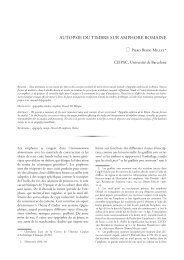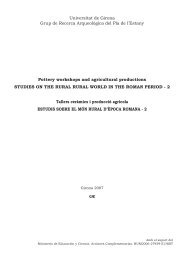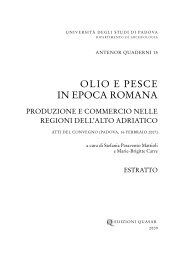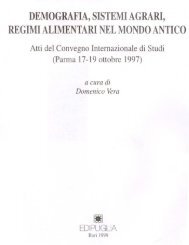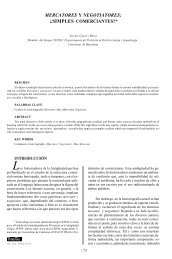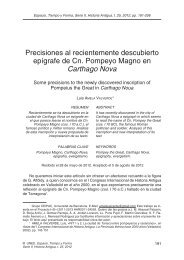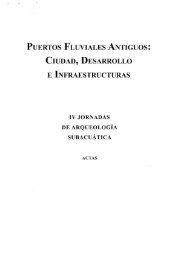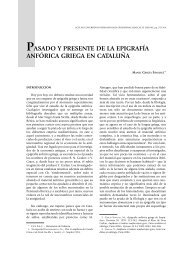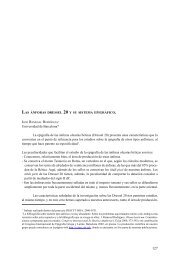roman amphora trade across the straits of gibraltar - Wiley Online ...
roman amphora trade across the straits of gibraltar - Wiley Online ...
roman amphora trade across the straits of gibraltar - Wiley Online ...
Create successful ePaper yourself
Turn your PDF publications into a flip-book with our unique Google optimized e-Paper software.
FELIX TEICHNER AND LLUÍS PONS PUJOL<br />
ROMAN AMPHORA TRADE ACROSS THE STRAITS OF<br />
GIBRALTAR: AN ANCIENT ‘ANTI-ECONOMIC PRACTICE’?<br />
Summary. Olive oil and fish products from <strong>the</strong> south <strong>of</strong> Hispania and North<br />
Africa played an important role in <strong>the</strong> Roman economy. The authors call<br />
attention to <strong>the</strong> asymmetrical distribution <strong>of</strong> archaeological data available on<br />
this subject, in particular <strong>the</strong> location <strong>of</strong> <strong>amphora</strong> kilns, and try to give an<br />
explanation, based on <strong>the</strong> evolution <strong>of</strong> European archaeology in <strong>the</strong> twentieth<br />
century.<br />
This paper focuses on Roman maritime <strong>trade</strong> in <strong>the</strong> ‘Circle <strong>of</strong> <strong>the</strong> Straits’, 1 <strong>the</strong> area<br />
between <strong>the</strong> provinces <strong>of</strong> Baetica (Andalucia) and Mauretania Tingitana (Morocco), where<br />
‘. . . both <strong>the</strong> Baetis and <strong>the</strong> Anas empty, and <strong>the</strong> limits <strong>of</strong> Maurusia, <strong>the</strong> Atlantic Ocean breaks<br />
in and thus forms <strong>the</strong> strait at <strong>the</strong> Pillars, and by this strait <strong>the</strong> interior sea connects with <strong>the</strong><br />
exterior sea’ (Strabo III 1, 7: trans. H.L. Jones, Loeb edition 1923). It will not judge or discuss<br />
<strong>the</strong> question <strong>of</strong> rationality or irrationality in <strong>the</strong> ancient economy for which <strong>the</strong> reader is referred<br />
to <strong>the</strong> relevant recent bibliography (Rathbone 1991; Andreau and Maucourant 1999; Lo Cascio<br />
and Rathbone 2000; Scheidel and von Reden 2002; Christensen 2003; Andreau 2005; Carrié<br />
2005; Lautman 2005; Minaud 2005; Rathbone 2005; Tchernia 2005).<br />
The historical and economic context is well known. From <strong>the</strong> beginning <strong>of</strong> <strong>the</strong> Roman<br />
occupation <strong>of</strong> <strong>the</strong> Iberian Peninsula, <strong>the</strong> fertile valley <strong>of</strong> <strong>the</strong> Baetis – <strong>the</strong> later Guadalquivir –<br />
played a key role in <strong>the</strong> Romanization <strong>of</strong> Iberia (Keay 1998). The export <strong>of</strong> olive oil formed<br />
<strong>the</strong> basis for <strong>the</strong> prosperity <strong>of</strong> many <strong>of</strong> <strong>the</strong> cities in this area throughout <strong>the</strong> period <strong>of</strong> <strong>the</strong><br />
Roman Empire. In <strong>the</strong> same way, <strong>the</strong> rich fish stock in <strong>the</strong> Straits <strong>of</strong> Gibraltar, particularly<br />
tuna, was exploited by several coastal manufactories (cetariae) dedicated to salted fish<br />
(salsamenta) and fish sauce (garum et liquamen) (Lagóstena 1996a; 1996b; 2001; Lagóstena<br />
et al. 2007). Both products were subsequently distributed all over <strong>the</strong> Roman Empire,<br />
including <strong>the</strong> north-western frontier in Germania and Britannia (Remesal 1986; 1998a;<br />
Carrerras 2000; Remesal 2002; Étienne and Mayet 2002; Ehmig 2003). Besides <strong>the</strong> numerous<br />
shipwrecks from this period, <strong>the</strong> large dump at <strong>the</strong> capital in Rome (<strong>the</strong> so-called Monte<br />
Testaccio) has given a vivid impression <strong>of</strong> <strong>the</strong> large number <strong>of</strong> ceramic containers (<strong>amphora</strong>e)<br />
1 The expression was created by Tarradell, although it was Ponsich who developed it, taking into account<br />
geopolitical factors: Tarradell 1959; 1960, 61; 1967; Ponsich 1970, 20; 1975; Remesal 1983; Ponsich 1991b;<br />
1993; Chaves et al. 1998; Pons 2000, 1251–3; Niveau de Villedary 2001; Arévalo et al. 2004.<br />
OXFORD JOURNAL OF ARCHAEOLOGY 27(3) 303–314 2008<br />
© 2008 The Authors<br />
Journal compilation © 2008 Blackwell Publishing Ltd., 9600 Garsington Road, Oxford OX4 2DQ, UK<br />
and 350 Main Street Malden, MA 02148, USA. 303
ROMAN AMPHORA TRADE ACROSS THE STRAITS OF GIBRALTAR<br />
used for <strong>the</strong> transport <strong>of</strong> olive oil. Amphora stamps and graffiti (tituli picti) <strong>of</strong>fer an interesting<br />
field for studying <strong>the</strong> details <strong>of</strong> this ancient <strong>trade</strong>. For this reason, <strong>the</strong>re has been a growing<br />
preoccupation with <strong>the</strong> analysis <strong>of</strong> <strong>the</strong>se phenomena in recent years, dominated by ancient<br />
historians, epigraphists and pottery analysts (Harris 1993; Blázquez et al. 1994; Blázquez and<br />
Remesal 1999; 2001; 2003; Remesal 2004). At <strong>the</strong> same time, interdisciplinarity in fields like<br />
chemistry or mineralogy has created new tools, especially for questions relating to <strong>the</strong> origin<br />
and distribution <strong>of</strong> <strong>the</strong> <strong>amphora</strong>e (Di Filippo et al. 1996; 1999; Grubessi 1999; Grubessi and<br />
Conti 1999; Conti et al. 1999; Ehmig 2003; Congreso 2001).<br />
In <strong>the</strong> case <strong>of</strong> <strong>the</strong> olive oil <strong>trade</strong> from sou<strong>the</strong>rn Spain, raw data are provided on <strong>the</strong> one<br />
hand by <strong>the</strong> <strong>amphora</strong>e found at <strong>the</strong> receiving end, as at Monte Testaccio in Rome and <strong>the</strong> frontier<br />
zone in <strong>the</strong> north-west, while on <strong>the</strong> o<strong>the</strong>r hand, <strong>the</strong> analysis <strong>of</strong> <strong>the</strong> distribution <strong>of</strong> <strong>the</strong> <strong>amphora</strong><br />
stamps <strong>the</strong>mselves in <strong>the</strong> area <strong>of</strong> origin has revealed significant information about <strong>the</strong><br />
organization, localization and structure <strong>of</strong> <strong>the</strong> figlinae and <strong>the</strong>ir system <strong>of</strong> commercialization<br />
(Remesal 1977/78; 1980; 1989; Remesal et al. 1997; Pons and Berni 2002; Bernal and<br />
Lagóstena 2004). In contrast, <strong>the</strong>re is a lack <strong>of</strong> detailed information for identifying <strong>the</strong> complex<br />
installations necessary in <strong>the</strong> production <strong>of</strong> oil, not only <strong>the</strong> various kilns used for <strong>the</strong><br />
manufacturing <strong>of</strong> <strong>the</strong> <strong>amphora</strong>e, but also <strong>the</strong> oil presses and mills <strong>the</strong>mselves. For example, <strong>the</strong>re<br />
are numerous indications <strong>of</strong> olive presses or elements throughout <strong>the</strong> entire Baetis Valley<br />
(Ponsich 1974; 1979; 1987; 1991a; Remesal 1998b; Serrano 2005), but <strong>the</strong> largest excavated<br />
pars rustica dedicated to olive oil production is located, interestingly, in <strong>the</strong> neighbouring<br />
province <strong>of</strong> Lusitania. In an area in which we have, at <strong>the</strong> moment, no evidence for <strong>the</strong><br />
production <strong>of</strong> <strong>the</strong> typical olive oil <strong>amphora</strong> Dressel 20, recent excavations at <strong>the</strong> Roman villa at<br />
Milreu (Estói) have brought to light a large olive oil production complex, consisting <strong>of</strong> five<br />
presses arranged in a line and storage rooms with a large quantity <strong>of</strong> dolia (Neville and Teichner<br />
2000; Teichner 2001; 2002; 2004; 2005; 2008).<br />
In <strong>the</strong> case <strong>of</strong> garum production in <strong>the</strong> south <strong>of</strong> Iberia, <strong>the</strong> situation seems to be reversed.<br />
The epigraphic sources, especially <strong>the</strong> information provided by <strong>amphora</strong> stamps, are poorer, but<br />
a large number <strong>of</strong> production vats have been excavated all around <strong>the</strong> coast <strong>of</strong> Iberia. These<br />
characteristic fish-salting tanks, lined with opus signinum and always located near <strong>the</strong> sea, are a<br />
clear indication <strong>of</strong> <strong>the</strong> production <strong>of</strong> salted fish and garum in antiquity (Lagóstena et al. 2007).<br />
At <strong>the</strong> same time, we have much information about <strong>the</strong> typical <strong>amphora</strong>e used for <strong>the</strong>se fish<br />
products. One <strong>of</strong> <strong>the</strong> best known regions for this ancient coastal economy includes <strong>the</strong> river<br />
estuaries <strong>of</strong> <strong>the</strong> Tejo and Sado near Lisbon. Intensive research by Portuguese and French<br />
archaeologists has shown, in this micro-region, a complex interaction between <strong>amphora</strong> potters<br />
and fish sauce producers in <strong>the</strong> same centres, such as Caetobriga (Setubal), Troia and Felicitas<br />
Iulia Olisipo (Lisbon) itself. 2 But surprisingly enough, while we have an enormous number <strong>of</strong><br />
fish salting and fish sauce production sites along <strong>the</strong> entire Lusitanian coastline (including <strong>the</strong><br />
Algarve coast), <strong>the</strong> typical Lusitanian fish sauce <strong>amphora</strong>, <strong>the</strong> Almagro 50 and 51a–c, seems to<br />
be under-represented east <strong>of</strong> <strong>the</strong> columns <strong>of</strong> Heracles (Fabião 2004). The amount <strong>of</strong> Lusitanian<br />
<strong>amphora</strong>e in <strong>the</strong> commercial area <strong>of</strong> <strong>the</strong> mare nostrum and <strong>the</strong> neighbouring provinces is so small<br />
that Spanish researchers have recently considered <strong>the</strong> possibility that o<strong>the</strong>r containers were filled<br />
2 Étienne, Makaroun and Mayet 1994; Mayet, Schmitt and Tavares da Silva 1996; Mayet and Tavares da Silva 1998;<br />
2002. Comp. for <strong>the</strong> purple-production in Lusitania: Teichner 2006; 2007; 2008.<br />
304<br />
OXFORD JOURNAL OF ARCHAEOLOGY<br />
© 2008 The Authors<br />
Journal compilation © 2008 Blackwell Publishing Ltd.
FELIX TEICHNER AND LLUÍS PONS PUJOL<br />
with Lusitanian products before reaching <strong>the</strong> Mediterranean, probably at Gades (Cadiz), <strong>the</strong><br />
most important harbour <strong>of</strong> Baetica (Lagóstena et al. 2007).<br />
This brings us directly back to <strong>the</strong> economic region <strong>of</strong> <strong>the</strong> Straits <strong>of</strong> Gibraltar: <strong>the</strong><br />
importance and predominance <strong>of</strong> Baetican producers and <strong>trade</strong>rs in <strong>the</strong> region is a central trend<br />
in <strong>the</strong> current interpretation <strong>of</strong> <strong>the</strong> Roman economy. The exports from <strong>the</strong> Roman province south<br />
<strong>of</strong> <strong>the</strong> Straits, Mauretania Tingitana, are seen merely as a continuation <strong>of</strong> <strong>the</strong> Baetican economy.<br />
Thanks to intensive French research carried out in Morocco and Algeria, some <strong>of</strong> <strong>the</strong><br />
largest installations for fish sauce production from <strong>the</strong> Roman imperial period are known in this<br />
area. Sites like Cotta and Lixus and <strong>the</strong>ir architecture are synonyms for fishing and <strong>the</strong><br />
manufacturing <strong>of</strong> salsamenta and garum. 3 But, surprisingly enough, we have little information<br />
about <strong>the</strong> production <strong>of</strong> <strong>the</strong> necessary containers, <strong>the</strong> <strong>amphora</strong>e, in Mauretania Tingitana.<br />
Certainly, some tituli picti on <strong>amphora</strong>e such as CO(r)D(ula) LIX(itana) VE(tus) or CO(r)D(ula)<br />
TING(itana) VET(us) prove <strong>the</strong>ir African origin (CIL IV, 5629, 5630, 5631, 5632, 5636, 5637;<br />
Liou 1987, 66–9; Martín-Kilcher 1994, 404 p. 27; Étienne and Mayet 1998, 39–40; Martínez<br />
Maganto 2001). The lack <strong>of</strong> kilns producing <strong>the</strong>se <strong>amphora</strong>e in <strong>the</strong> area is <strong>the</strong> starting point for<br />
<strong>the</strong> creation <strong>of</strong> a <strong>the</strong>ory concerning <strong>the</strong> ancient economy <strong>of</strong> Baetica and Tingitana: it has been<br />
postulated in <strong>the</strong> last decade by Spanish researchers that Baetica provided containers <strong>of</strong> fish<br />
sauce to Tingitana. The syllogism <strong>of</strong> this hypo<strong>the</strong>sis is based on <strong>the</strong> following premises. First:<br />
Tingitana was a great producer <strong>of</strong> fish sauce but not <strong>of</strong> <strong>amphora</strong>e in which to transport <strong>the</strong>se<br />
liquids. Secondly: Baetica was a producer both <strong>of</strong> fish sauce and <strong>of</strong> fish sauce containers.<br />
Conclusion: <strong>the</strong> fish sauce from Tingitana was packed in Baetican containers. This argument has<br />
logic, but it may not relate to <strong>the</strong> historical truth, given that it has been built upon partial data, and<br />
excessive emphasis on <strong>the</strong> predominance <strong>of</strong> Gades and <strong>the</strong> omnipresence <strong>of</strong> <strong>the</strong> economic<br />
influence <strong>of</strong> <strong>the</strong> ‘Circle <strong>of</strong> <strong>the</strong> Straits’.<br />
The first to suggest this hypo<strong>the</strong>sis was M. Ponsich (1975, 672, 677). In his view, Gades<br />
controlled fishing and garum production, both on <strong>the</strong> European and African shores <strong>of</strong> <strong>the</strong> Straits,<br />
so it was natural that it should impose <strong>the</strong> use <strong>of</strong> Baetican fish sauce containers. This would mean<br />
<strong>the</strong> substitution <strong>of</strong> <strong>the</strong> Baetican Dressel 7–11 <strong>amphora</strong> for <strong>the</strong> autochthonous Mañá C2 <strong>amphora</strong>. 4<br />
The containers would have been produced in Gades and transported empty to Tingitana, filled<br />
with Tingitanian fish sauce and returned to Gades, from where <strong>the</strong>y were exported to <strong>the</strong> entire<br />
western Mediterranean as a product <strong>of</strong> Gaditan origin. 5<br />
The idea has been maintained until very recently, contrary to archaeological fact, that no<br />
kilns capable <strong>of</strong> producing <strong>the</strong> fish sauce <strong>amphora</strong>e have been found in Tingitana. 6 But <strong>the</strong> idea<br />
that empty <strong>amphora</strong>e were transported seems to be, as one <strong>of</strong> <strong>the</strong> authors described it, one <strong>of</strong><br />
‘severe irrationality’ (Pons 2000, 1260–1; 2002/3, 392). On <strong>the</strong> one hand, it was completely<br />
uneconomic to produce <strong>the</strong> containers for goods on <strong>the</strong> European shore <strong>of</strong> <strong>the</strong> Straits and to<br />
produce <strong>the</strong> goods <strong>the</strong>mselves on <strong>the</strong> African shore, because <strong>the</strong> <strong>amphora</strong>e were extremely cheap<br />
and easy to manufacture. On <strong>the</strong> o<strong>the</strong>r hand, in Tingitana, several firing failures <strong>of</strong> a variety <strong>of</strong><br />
fish sauce vessels from <strong>the</strong> Republican period and <strong>the</strong> early Empire were already known, which<br />
3 Cotta: Ponsich and Tarradell 1965, 55–68; Ponsich 1988, 150–9. Lixus: Ponsich and Tarradell 1965, 93–7;<br />
Ponsich 1988, 103–36.<br />
4 This process was initiated in <strong>the</strong> Bay <strong>of</strong> Cádiz, cf. Lagóstena 1996a; 1996b, 151–3; 2001, 277–8.<br />
5 Strab. 2; 3. 1; 4; Ponsich 1975, 672, 677 with bibliography; Étienne and Mayet 1998.<br />
6 Villaverde 1992, 334–7; Villaverde and López Pardo 1995; Bravo et al. 1995; Villaverde 2001; Bernal and Pérez<br />
2001, 876–8; Gozalbes 2001; 2002, 133–5. Cf. Pons 2007 for details on each author’s hypo<strong>the</strong>sis.<br />
OXFORD JOURNAL OF ARCHAEOLOGY<br />
© 2008 The Authors<br />
Journal compilation © 2008 Blackwell Publishing Ltd. 305
ROMAN AMPHORA TRADE ACROSS THE STRAITS OF GIBRALTAR<br />
hinted at <strong>the</strong> possibility <strong>of</strong> <strong>the</strong> appearance <strong>of</strong> later kilns. 7 One should, <strong>the</strong>refore, have expected<br />
to find kilns dedicated to <strong>the</strong> production <strong>of</strong> fish sauce <strong>amphora</strong>e in <strong>the</strong> early Empire in Morocco<br />
(Pons 2000, 1260–1). In fact, this happened in 2000, when an Italian–Moroccan mission found<br />
and excavated kilns at Thamusida (Sidi Ali ben Ahmed, Morocco) that produced <strong>amphora</strong>e from<br />
<strong>the</strong> Dressel 7–11 and Beltran IIB types. 8<br />
Even if <strong>the</strong>se recent results, when fully published, lead to a correction <strong>of</strong> <strong>the</strong> existing<br />
models <strong>of</strong> <strong>the</strong> economy <strong>of</strong> <strong>the</strong> ‘circle <strong>of</strong> <strong>the</strong> Straits’, it is worthwhile checking <strong>the</strong> reasons for <strong>the</strong><br />
existing asymmetrical distribution <strong>of</strong> archaeological data on both shores. Looking carefully at<br />
<strong>the</strong> history <strong>of</strong> scientific fieldwork in <strong>the</strong> area during <strong>the</strong> twentieth century, it is possible to find<br />
reasons for <strong>the</strong> ‘lack <strong>of</strong> kilns’ in Tingitana.<br />
It is an open secret that archaeological investigation is always strongly influenced by <strong>the</strong><br />
historical context, namely <strong>the</strong> availability <strong>of</strong> financial support, cultural legislation and public<br />
attention. In Roman times, <strong>the</strong> sea between Africa and Europe was merely an internal boundary<br />
separating two provinces <strong>of</strong> <strong>the</strong> same Empire. But after <strong>the</strong> final triumph <strong>of</strong> Catholic Spain, <strong>the</strong><br />
conquest <strong>of</strong> Granada in 1492, <strong>the</strong> situation changed. Gibraltar, <strong>the</strong> Gabel-al-Tarik, marks in<br />
modern times a frontier between two cultural, religious and economic systems.<br />
As regards <strong>the</strong> history <strong>of</strong> archaeological investigation in Mauritania Tingitana, we must<br />
be aware that most <strong>of</strong> our knowledge dates back to <strong>the</strong> French and Spanish presence in North<br />
Africa. All <strong>the</strong> famous fish sauce production centres mentioned above – such as Lixus and Cotta<br />
– were excavated in <strong>the</strong> 1950s and 1960s by ‘European’ scholars such as M. Ponsich and M.<br />
Tarradell. Thanks to <strong>the</strong>ir intensive fieldwork we are familiar with <strong>the</strong> impressive architecture <strong>of</strong><br />
<strong>the</strong>se production buildings (cetariae). But in <strong>the</strong> bibliography <strong>of</strong> that time, systematic analyses<br />
<strong>of</strong> small finds were restricted to oil-lamps as part <strong>of</strong> <strong>the</strong> art-historically-influenced typological<br />
studies <strong>of</strong> fine wares, 9 while coarse wares or <strong>amphora</strong>e were only very rarely studied.<br />
Unsurprisingly, <strong>the</strong> major changes in political systems in North Africa in <strong>the</strong> middle <strong>of</strong><br />
<strong>the</strong> twentieth century had a specific impact on archaeological investigation in this region. After<br />
<strong>the</strong> independence <strong>of</strong> Morocco in 1956 and Algeria in 1962, <strong>the</strong> situation became more difficult<br />
for archaeologists from Europe. Most <strong>of</strong> <strong>the</strong> fieldwork projects in this area stopped. Scholars who<br />
had previously been in charge <strong>of</strong> investigations in Roman North Africa ‘migrated’ to <strong>the</strong> Iberian<br />
Peninsula. Many important projects relating to <strong>the</strong> archaeology <strong>of</strong> Hispania Romana, for<br />
example <strong>the</strong> excavations at Baelo Claudia (Spain) or at Conimbriga (Portugal), as well as <strong>the</strong><br />
important survey work done in <strong>the</strong> Baetis Valley and in <strong>the</strong> Sado and Tejo region, were initiated<br />
as a result. 10<br />
7 Mañá A and B: Banasa (Arharbi and Lenoir 1998). Mañá C2b: Kouass (a syn<strong>the</strong>sis in Aranegui et al. 2004,<br />
366–7); Banasa (Arharbi et al. 2001; Arharbi and Lenoir 2004; Aranegui et al. 2004, 364–5); Volubilis (Majdoub<br />
1996, 297–300); Sala (Boube 1987/88 [1994], 191–2 n. 66). Dressel 7/11: Tamuda (Majdoub 1994, 302); Zilil<br />
(Pons 2000, 1261); Lixus (Izquierdo et al. 2001, 160–1; Bonet et al. 2005, 127); Sala (Boube 1987/88, 193;<br />
Arharbi and Naji 2004, 183 n. 61); Volubilis (Behel 1993, 343–7 apud Arharbi and Naji 2004, 183 n. 59). Sala<br />
I/Lomba do Canho: Sala (Boube 1973/75, 227–30; 1979/80; 1987/88, 186–8; Boube 1999, 67). Dressel<br />
9?/Dressel 10?: Aïn Mesbah (Pons 2002/3, 392 n. 1; Bonet et al. 2005, 122 n. 7; Arharbi and Naji 2004, 187;<br />
Aranegui et al. 2004, 368; Pons 2007). Haltern 70?: Aïn Mesbah (idem); Sala (Boube 1973/75, 227 nos. 113–14).<br />
8 Pons 2007; 2008; Laura Cerri’s paper in <strong>the</strong> same Proceedings and http://www.archeo.unisi.it/<br />
Archeologia_classica/province_<strong>roman</strong>e/thamusida/fornaci.html.<br />
9 For example: Ponsich 1961; Deneauve 1969.<br />
10 Baelo: Sillières 1995. Conimbriga: Itineraires 1997. Baetica: Ponsich 1974; 1979; 1987; 1991a. Sado/Tejo region:<br />
Étienne, Makaroun and Mayet 1994; Étienne and Mayet 2002.<br />
306<br />
OXFORD JOURNAL OF ARCHAEOLOGY<br />
© 2008 The Authors<br />
Journal compilation © 2008 Blackwell Publishing Ltd.
35<br />
30<br />
25<br />
20<br />
15<br />
10<br />
5<br />
0<br />
1924<br />
1927<br />
FELIX TEICHNER AND LLUÍS PONS PUJOL<br />
1930<br />
1933<br />
1936<br />
1939<br />
1942<br />
1945<br />
1948<br />
1951<br />
1954<br />
1957<br />
1960<br />
1963<br />
1966<br />
1969<br />
1972<br />
1975<br />
1978<br />
1981<br />
1984<br />
1987<br />
1990<br />
1993<br />
1996<br />
1999<br />
2002<br />
Figure 1<br />
The graph shows <strong>the</strong> absolute number <strong>of</strong> publications dedicated to <strong>the</strong> Roman archaeology and history <strong>of</strong> <strong>the</strong> Iberian<br />
Peninsula (Portugal and Spain: white line) and <strong>the</strong> opposing side <strong>of</strong> <strong>the</strong> Straits (Morocco, Algeria, Mauritania and<br />
Tunisia: black line) between 1924 and 2002 (source: 1924–1976 Année Philologique; 1976–1993 Archäologische<br />
Bibliographie (DAI); 1994–2003 Dyabola (DAI)).<br />
Progress in archaeological methodology meant that this fieldwork was no longer<br />
dedicated only to architecture and ‘les beaux-arts’. Systematic investigation <strong>of</strong> <strong>the</strong> cetariae<br />
inside a Roman city centre (in <strong>the</strong> case <strong>of</strong> Baelo) was combined with <strong>the</strong> investigation <strong>of</strong> <strong>the</strong><br />
typology <strong>of</strong> <strong>the</strong> <strong>amphora</strong>e and <strong>the</strong> pottery kilns in <strong>the</strong> hinterland in order to gain a wider picture<br />
<strong>of</strong> <strong>the</strong> Roman economy in a certain region (‘micro-economy’). These new directions in <strong>the</strong><br />
archaeology <strong>of</strong> <strong>the</strong> 1970s were adopted by <strong>the</strong> national archaeology <strong>of</strong> post-Franco Spain and<br />
post-Salazar Portugal, with important results. 11 The improvement <strong>of</strong> cultural heritage legislation,<br />
<strong>the</strong> installation <strong>of</strong> local archaeologists and new regional universities led to a boom in<br />
archaeology. In <strong>the</strong> case <strong>of</strong> Baetica it is not just <strong>the</strong> intensive investigation <strong>of</strong> Phoenician, Punic<br />
and Roman economic activity – especially <strong>amphora</strong> production – in <strong>the</strong> Bay <strong>of</strong> Cadiz that<br />
impresses. For example, during <strong>the</strong> 1980s and 1990s it was possible to identify numerous pottery<br />
workshops, <strong>the</strong> figlinae for coarse ware and <strong>amphora</strong>e, throughout <strong>the</strong> entire province <strong>of</strong> Baetica<br />
(Bernal and Lagóstena 2004).<br />
But on <strong>the</strong> opposite side <strong>of</strong> <strong>the</strong> Straits <strong>of</strong> Gibraltar, archaeological fieldwork failed to<br />
progress at <strong>the</strong> same rate. On <strong>the</strong> basis <strong>of</strong> <strong>the</strong> recorded bibliographies in <strong>the</strong> Année Philologique<br />
and <strong>the</strong> Archäologische Bibliographie <strong>of</strong> <strong>the</strong> Deutsches Archäologisches Institut, referring to<br />
Spain and Portugal on <strong>the</strong> one hand (Fig. 1, white line) and to Morocco, Algeria, Mauritania and<br />
Tunisia on <strong>the</strong> o<strong>the</strong>r hand (Fig. 1, black line), a simple graph shows <strong>the</strong> evolution <strong>of</strong> Roman<br />
archaeology in both regions. In particular, <strong>the</strong> data in <strong>the</strong> Année Philologique, founded in Paris<br />
by <strong>the</strong> Latinist Jules Marouzeau (1878–1964), indicate <strong>the</strong> significance <strong>of</strong> French archaeological<br />
investigation in North Africa in <strong>the</strong> first half <strong>of</strong> <strong>the</strong> twentieth century. In contrast, at <strong>the</strong> same<br />
time, publications referring to Hispania Romana were few. World War II, with all <strong>the</strong> struggles<br />
in North Africa, does not seem to have had a large impact on investigations in <strong>the</strong> area. Only <strong>the</strong><br />
11 For Portugal: C. Fabião, Archaeology and nationalism: <strong>the</strong> Portuguese case. In Díaz and Champion 1996, 90–107.<br />
For Spain: Díaz 1993; 1997; Gozalbes 2003; M. Díaz-Andreu, Islamic archaeology and <strong>the</strong> origin <strong>of</strong> <strong>the</strong> Spanish<br />
nation. In Díaz and Champion 1996, 68–89.<br />
OXFORD JOURNAL OF ARCHAEOLOGY<br />
© 2008 The Authors<br />
Journal compilation © 2008 Blackwell Publishing Ltd. 307
ROMAN AMPHORA TRADE ACROSS THE STRAITS OF GIBRALTAR<br />
end <strong>of</strong> <strong>the</strong> French and Spanish presence in Algeria and Morocco marked a turning point<br />
for Roman archaeology in <strong>the</strong>se countries, now <strong>of</strong>ten referred as ‘pre-Islamic archaeology’.<br />
Simultaneously, <strong>the</strong> number <strong>of</strong> publications on Roman Hispania increased significantly during<br />
<strong>the</strong> 1970s, reaching a peak during <strong>the</strong> new democratic systems <strong>of</strong> <strong>the</strong> 1980s and 1990s (Wulff<br />
and Álvarez 2003).<br />
Returning to <strong>the</strong> problem <strong>of</strong> <strong>the</strong> apparent lack <strong>of</strong> <strong>amphora</strong> production in Mauretania<br />
Tingitana, <strong>the</strong> graph <strong>of</strong>fers a simple explanation. In <strong>the</strong> second half <strong>of</strong> <strong>the</strong> last century, at <strong>the</strong> time<br />
when Islamic archaeology in North Africa was gaining importance at <strong>the</strong> expense <strong>of</strong> Roman<br />
archaeology, in Spain and Portugal progress continued to be made. North <strong>of</strong> <strong>the</strong> Straits,<br />
archaeologists no longer dedicated <strong>the</strong>ir time only to <strong>the</strong> discovery <strong>of</strong> fine arts and main<br />
architectural buildings, but also paid <strong>the</strong> same amount <strong>of</strong> attention to small finds and landscape<br />
archaeology, important for modelling <strong>the</strong> complex ancient reality and economy. In particular,<br />
new methods and techniques <strong>of</strong> fieldwork and excavation facilitated progress in identifying, for<br />
example, <strong>the</strong> large number <strong>of</strong> Roman pottery kilns and figlinae.<br />
It seems, <strong>the</strong>refore, more likely that <strong>the</strong> lack <strong>of</strong> <strong>amphora</strong> kilns in Tingitana is a reflection<br />
<strong>of</strong> <strong>the</strong> evolution <strong>of</strong> European archaeological investigation in <strong>the</strong> twentieth century, ra<strong>the</strong>r than a<br />
representative image <strong>of</strong> <strong>the</strong> ancient reality. Hence, we have to consider that <strong>the</strong> current state <strong>of</strong><br />
investigation does not allow us to postulate <strong>the</strong> transport <strong>of</strong> Roman <strong>amphora</strong>e from sou<strong>the</strong>rn<br />
Baetica, especially from <strong>the</strong> economically important area <strong>of</strong> Gades (Cadiz) and <strong>the</strong> surrounding<br />
villages such as Puerto Real and Puerto de Santa María, to nor<strong>the</strong>rn Africa. As Y. Garlan puts it<br />
‘(...)comme [<strong>the</strong> <strong>amphora</strong>e] ...nevalaient pas tant par elles mêmes que par leur contenu et<br />
que leur fabrication ne devait généralement pas poser de problème, elles avaient en effet peu de<br />
chances d’être transportées vides sur de longues distances, à partir de leur lieu d’origine’<br />
(Garlan 1983, 37).<br />
Special caution should be exercised in <strong>the</strong> case <strong>of</strong> every conclusion ‘ex silentio’. For<br />
example, <strong>the</strong> similar transport <strong>of</strong> empty <strong>amphora</strong>e has also been suggested for o<strong>the</strong>r regions <strong>of</strong><br />
<strong>the</strong> ancient world: <strong>the</strong> shipping <strong>of</strong> empty <strong>amphora</strong>e from Rhodes to Alexandria or sites on <strong>the</strong><br />
Black Sea has been raised as a feasible response to <strong>the</strong> poor quality <strong>of</strong> clay in <strong>the</strong> receiving<br />
centres. 12 R. Étienne considers that <strong>the</strong> wine produced on <strong>the</strong> island <strong>of</strong> Mallorca during <strong>the</strong> first<br />
century BC could have been exported in <strong>amphora</strong>e from <strong>the</strong> nearby kilns <strong>of</strong> <strong>the</strong> island <strong>of</strong> Ebusus<br />
(Ibiza) (Étienne 1982, 11–12). And more recently, D. Bernal has proposed <strong>the</strong> hypo<strong>the</strong>sis for <strong>the</strong><br />
city <strong>of</strong> Baelo Claudia, a great producer <strong>of</strong> fish sauce where <strong>amphora</strong> kilns are not known, that its<br />
<strong>amphora</strong>e were supplied by sea from El Rinconcillo (Algeciras, Cádiz). He also proposes that<br />
various cetariae in <strong>the</strong> suburbs <strong>of</strong> Almuñecar would have had <strong>the</strong>ir containers supplied by <strong>the</strong><br />
workshop <strong>of</strong> Los Matagallares (Salobrena, Granada). Based upon <strong>the</strong>se two examples, he <strong>of</strong>fers<br />
<strong>the</strong> <strong>the</strong>ory <strong>of</strong> centralized figlinae provided with optimal conditions for ceramic production<br />
(water, clay and wood), placed near <strong>the</strong> coastline in order to export containers by sea. Perhaps<br />
this explains – as a consequence <strong>of</strong> his working hypo<strong>the</strong>sis – <strong>the</strong> concentration <strong>of</strong> workshops in<br />
<strong>the</strong> Bay <strong>of</strong> Cadiz and in <strong>the</strong> mouths <strong>of</strong> <strong>the</strong> Tejo and Sado (Bernal 1999).<br />
12 Sherwin-White 1978, 241; Sadurska 1961, 110. Contra Garlan 1983, 43 n. 2, ‘Il me parai invraisembable que<br />
Rhodes, par exemple, ait abondamment exporté des amphores vides à Alexandrie ou en Mer Noire, comme<br />
l’imaginent (...)Même dans les grands centres importateurs devait normalement exister une production locale<br />
d’amphores – à laquelle on ne s’est guère intéressé et qui reste le plus souvent difficile à identifier. Cela ne veut<br />
cependant pas dire, comme on le verra ci-dessous, qu’il n’ait pas existé de marchés locaux d’amphores vides,<br />
neues ou de récuperation’.<br />
308<br />
OXFORD JOURNAL OF ARCHAEOLOGY<br />
© 2008 The Authors<br />
Journal compilation © 2008 Blackwell Publishing Ltd.
It has been shown above that, in <strong>the</strong> case <strong>of</strong> Mauritania Tingitana, modern-day factors,<br />
caused in this particular case by post-colonialism, could be <strong>the</strong> reason for <strong>the</strong> asymmetrical<br />
distribution <strong>of</strong> archaeological data and information. Hence, conclusions drawn from this may be<br />
biased and do not necessarily reflect <strong>the</strong> ancient reality. As in any o<strong>the</strong>r discipline, landscape<br />
archaeology and its distribution maps need to pay attention to methodological problems,<br />
o<strong>the</strong>rwise raw data are liable to be quarried in search <strong>of</strong> arguments to prove pre-existing <strong>the</strong>ories.<br />
Acknowledgements<br />
FELIX TEICHNER AND LLUÍS PONS PUJOL<br />
We wish to thank Pr<strong>of</strong>essor Jean Andreau (EHESS, Paris), Pr<strong>of</strong>essor Andrew Wilson (Oxford)<br />
and Pr<strong>of</strong>essor José Remesal Rodriguez (CEIPAC, Barcelona) for <strong>the</strong>ir kind suggestions.<br />
(FT) Institut für Archäologische Wissenschaften II<br />
Archäologie und Geschichte der römischen Provinzen sowie Hilfswissenschaften der<br />
Altertumskunde<br />
Johann-Wolfgang-Goe<strong>the</strong>-Universität<br />
Grüneburgplatz 1<br />
60323 Frankfurt am Main<br />
GERMANY<br />
e-mail: teichner@em.uni-frankfurt.de<br />
(LPP) Universidad de Cádiz<br />
Seminario Agustin de Horozco<br />
E-11002 Cadiz<br />
SPAIN<br />
e-mail: luis.pons@uca.es<br />
references<br />
andreau, j. 2005: La modernité du domaine d’Appianus. Topoi (Paris) 12, 304–9.<br />
andreau, j. and maucourant, j. 1999: A propos de la ‘rationalité économique’ dans l’Antiquité grécoromaine.<br />
Une interprétation des thèses de Dominic Rathbone (1991). Topoi (Paris) 9, 47–102.<br />
aranegui gascó, c., Kbiri alaoui, m. and vives-ferrándiz sánchez, j. 2004: Alfares y producciones<br />
cerámicas en Mauritania Occidental. In Bernal and Lagóstena 2004, 363–78.<br />
arévalo gonzález, a., bernal casasola, d. and torremocha silva, a. (eds.) 2004: Algeciras. Garum<br />
y salazones en el Círculo del Estrecho. Fundación Municipal de Cultura José Luis Cano, Mayo–<br />
Septiembre 2004 (Algeciras).<br />
arharbi, r. and lenoir, é. 1998: Banasa préromaine: novelles découvertes, mai 1997. Nouvelles<br />
Archéologiques et Patrimoniales 2, 8.<br />
arharbi, r. and lenoir, é. 2004: Les niveaux préromains de Banasa. Bulletin d’Archéologie Marocaine<br />
20, 220–70.<br />
arharbi, r., lenoir, é. and kermorvant, a. 2001: Iulia Valentia Banasa: de la découverte du site aux<br />
recherches récentes. In Plus d’un siècle de recherches archéologiques au Maroc. Actes de Ieres Journées<br />
Internationales d’Archéologie et du Patrimoine 2 (Rabat), 147–68.<br />
arharbi, r. and naji, h. 2004: Les amphores de Khedis à l’époque maurétanienne. In Zevi, G. and<br />
Turchetti, R., Méditerranée Occidentale antique: les échanges (Soveria Mannelli), 169–88.<br />
OXFORD JOURNAL OF ARCHAEOLOGY<br />
© 2008 The Authors<br />
Journal compilation © 2008 Blackwell Publishing Ltd. 309
ROMAN AMPHORA TRADE ACROSS THE STRAITS OF GIBRALTAR<br />
behel, m. 1993: Le versant Est de la ville ancienne de Volúbilis (Paris).<br />
bernal casasola, d. 1999: Transporte de envases vacíos en época <strong>roman</strong>a: a propósito de dos<br />
talleres anfóricos béticos de época alto (El Rinconcillo, Algeciras, Cádiz) y bajo imperial (Los<br />
Matagallares, Salobreña, Granada). In II Congreso de Arqueología Peninsular, Zamora 1996 4 (Zamora),<br />
359–61.<br />
bernal casasola, d. and lagóstena barrios, l. (eds.) 2004: Figlinae baeticae: talleres alfareros y<br />
producciones cerámicas en la Bética <strong>roman</strong>a (ss. II a.C.–VII d.C.): Actas del Congreso Internacional<br />
(Oxford, BAR Int. Ser. 1266).<br />
bernal casasola, d. and pérez rivera, j.m. 2001: Las ánforas de Septem Frates en los ss. II y III d.C.<br />
Un modelo de suministro de envases gaditanos a las factorías de salazones de la costa tingitana. In<br />
Congreso 2001, 861–87.<br />
blázquez martínez, j.m. and remesal rodríguez, j. (eds.) 1999: Estudios sobre el Monte Testaccio<br />
(Roma) I. Corpus International des Timbres Amphoriques 7 (Barcelona, Instrumenta 6).<br />
blázquez martínez, j.m. and remesal rodríguez, j. (eds.) 2001: Estudios sobre el Monte Testaccio<br />
(Roma) II. Corpus International des Timbres Amphoriques 8 (Barcelona, Instrumenta 10).<br />
blázquez martínez, j.m. and remesal rodríguez, j. (eds.) 2003: Estudios sobre el Monte Testaccio<br />
(Roma) III. Corpus International des Timbres Amphoriques 9 (Barcelona, Instrumenta 14).<br />
blázquez martínez, j.m., remesal rodríguez, j. and rodríguez almeida, e. 1994: Excavaciones<br />
arqueológicas en el Monte Testaccio (Roma). Memoria de la campaña 1989 (Madrid).<br />
bonet rosado, h., vives-ferrándiz sánchez, j., jhiri alaoui, m. and hassini, h. 2005: La ocupación<br />
púnico mauritania. In Aranegui Gascó, C. (ed.), Memoria de las excavaciones arqueológicas realizadas en<br />
la ladera sur de Lixus (Larache) por el equipo marroco-español entre 2000 y 2003 (Valencia, Saguntum<br />
Extra 6), 87–140.<br />
boube, j. 1973/75: Marques d’ámphores découvertes à Sala, Volubilis et Banasa. Bulletin d’Archéologie<br />
Marocaine 9, 163–235.<br />
boube, j. 1979/80: Amphores préromaines trouvées en mer au voisinage de Rabat. Bulletin d’Archéologie<br />
Marocaine 12, 99–109.<br />
boube, j. 1987/88: Les amphores de Sala à l’époque Mauretanienne. Bulletin d’Archéologie Marocaine 17,<br />
183–207.<br />
boube, j. 1999: Les nécropoles de Sala (Paris).<br />
bravo pérez, j., marfil ruiz, p., villada paredes, f. and hita ruiz, j.m. 1995: Nuevos datos sobre la<br />
economía del territorio ceutí en época <strong>roman</strong>a: las factorías de salazón. In II Congreso Internacional “El<br />
Estrecho de Gibraltar” – Ceuta 1990 1 (Madrid), 439–54.<br />
carreras monfort, c. 2000: Economía de la Britannia <strong>roman</strong>a: la importación de alimentos (Barcelona,<br />
Instrumenta 8).<br />
carrié, j.-m. 2005: Une rationalité quand même? Topoi (Paris) 12–13, 293–303.<br />
chaves tristán, f., garcía vargas, e. and ferrer albelda, e. 1998: Datos relativos a la pervivencia<br />
del denominado “Círculo del Estrecho” en época republicana. In L’Africa <strong>roman</strong>a XII 3 (Sassari), 1307–<br />
20.<br />
christensen, p. 2003: Economic rationalism in fourth century BC A<strong>the</strong>ns. Greece and Rome 50, 31–<br />
56.<br />
congreso 2001: Congreso Internacional Ex Baetica Amphorae. Conservas, aceite y vino de la Bética en<br />
el Imperio Romano. Sevilla–Écija, 17–20 de diciembre de 1998 (Écija).<br />
conti, l., burragato, f. and grubessi, o. 1999: Le anfore nordafricane del Monte Testaccio. In Blázquez<br />
and Remesal 1999, 473–512.<br />
deneauve, j. 1969: Lampes de Carthage (Paris).<br />
310<br />
OXFORD JOURNAL OF ARCHAEOLOGY<br />
© 2008 The Authors<br />
Journal compilation © 2008 Blackwell Publishing Ltd.
FELIX TEICHNER AND LLUÍS PONS PUJOL<br />
di filippo, m., grubessi, o. and toro, b. 1996: Un essempio di applicazione del metodo gravimetrico<br />
nell’area archeologica del Monte Testaccio (Roma). In Actes du colloque de Périgueux 1995 (Supplément<br />
à la Revue d’Archéométrie), 31–6.<br />
di filippo, m., grubessi, o. and toro, b. 1999: Progetto Testaccio. Indagine gravimetrica nell’area<br />
archeologica del Monte Testaccio (Roma). In Blázquez and Remesal 1999, 445–52.<br />
díaz-andreu, m. 1993: Theory and ideology in archaeology. Spanish archaeology under <strong>the</strong> Franco<br />
regime. Antiquity 67, 74–82.<br />
díaz-andreu, m. 1997: Prehistoria y Franquismo. In Mora, G. and Díaz-Andreu, M., La cristalización del<br />
pasado: génesis y desarrollo del marco institucional de la arqueología en España (Málaga), 547–52.<br />
díaz-andreu, m. and champion, t. 1996: Nationalism and archaeology in Europe (London).<br />
ehmig, u. 2003: Die römische Amphoren aus Mainz (Möhnesee).<br />
étienne, r. 1982: Le vin des Baléars. In Majorque, Languedoc et Roussillon de l’Antiquité à nos jours<br />
(Montpellier), 5–12.<br />
étienne, r., makaroun, y. and mayet, f. 1994: Un grand complexe industriel à Tróia (Portugal) (Paris).<br />
étienne, r. and mayet, f. 1998: Les mercatores de saumure hispanique. Mélanges de l’École Française<br />
à Rome 110, 147–65.<br />
étienne, r. and mayet, f. 2002: Salaisons et sauces de poisson hispaniques (Paris).<br />
fabião, c. 2004: Centros oleiros de Lusitânia. Balanço de conhecimentos e perspectivas de investigação.<br />
In Bernal and Lagóstena 2004, 349–410.<br />
garlan, y. 1983: Le commerce des amphores grecques. In Garnsey, P. and Whittaker, C.R. (eds.), Trade<br />
and Famine in Classical Antiquity (Cambridge), 37–44.<br />
gozalbes cravioto, e. 2001: Las ánforas béticas en Mauritana Tingitana ¿importación o exportación? In<br />
Congreso 2001, 887–99.<br />
gozalbes cravioto, e. 2002: Notas sobre las relaciones hispano-tingitanas en la antigüedad clásica. In<br />
Vivre, produire et échanger: reflets méditerranéens. Mélanges <strong>of</strong>ferts à Bernard Liou (Montagnac), 133–9.<br />
gozalbes cravioto, e. 2003: África Antigua en la historiografía y arqueología de época franquista. In<br />
Wulff and Álvarez 2003, 135–60.<br />
grubessi, o. 1999: Progetto Testaccio, Roma. Uno studio archeometrico delle anfore Dressel 20. In<br />
Blázquez and Remesal 1999, 365–424.<br />
grubessi, o. and conti, l. 1999: Progetto Testaccio. Studio archeometico delle anfore Dressel 20: nota II.<br />
Confronto analitico tra reperti spagnoli Tejarillo e La Catria e M. Testaccio. In Blázquez and Remesal<br />
1999, 513–42.<br />
harris, w.v. (ed.) 1993: The inscribed economy. Production and distribution in <strong>the</strong> Roman Empire in <strong>the</strong><br />
light <strong>of</strong> “instrumentum domesticum” (Ann Arbor, Journal <strong>of</strong> Roman Archaeology Suppl. 6).<br />
itineraires 1997: Itinéraires lusitaniens. Trente années de collaboration archéologique luso-française<br />
(Paris).<br />
izquierdo peraile, m.i., milou, b. and bonet rosado, h. 2001: Las fases púnico-mauritanas I (175/150<br />
a 80/50 a.C.) y II (80/50 a.C.–15 d.C.). In Aranegui Gascó, C. (ed.), Lixus, colonia fenicia y ciudad<br />
púnico-mauritana. Anotaciones sobre su ocupación medieval (Valencia, Saguntum Extra 4), 141–68.<br />
keay, s. 1998: The Archaeology <strong>of</strong> early Roman Baetica (Portsmouth, Journal <strong>of</strong> Roman Archaeology<br />
Suppl. 29).<br />
lagóstena barrios, l. 1996a: Alfarería <strong>roman</strong>a en la Bahía de Cádiz (Cádiz).<br />
lagóstena barrios, l. 1996b: Explotación del salazón en la Bahía de Cádiz en la Antigüedad: aportación<br />
al conocimiento de su evolución a través de la producción de las ánforas Mañá C. Florentia Iliberritana 7,<br />
141–69.<br />
OXFORD JOURNAL OF ARCHAEOLOGY<br />
© 2008 The Authors<br />
Journal compilation © 2008 Blackwell Publishing Ltd. 311
ROMAN AMPHORA TRADE ACROSS THE STRAITS OF GIBRALTAR<br />
lagóstena barrios, l. 2001: La producción de salas y conservas de pescado en la Hispania Romana (II<br />
a.C.–VI d.C.) (Barcelona, Instrumenta 11).<br />
lagóstena barrios, l., bernal casasola, d. and arévalo gonzález, a. (eds.) 2007: Cetariae 2005.<br />
Salsas y Salazones de Pescado en Occidente durante la Antigüedad. Actas del Congreso Internacional<br />
(Cádiz, 7–9 de noviembre de 2005) (Oxford, BAR Int. Ser. 1686).<br />
lautman, j. 2005: Entre magie et comptabilité. Topoi (Paris) 12–13, 311–14.<br />
liou, b. 1987: Inscriptions peintes sur amphores: Fos (suite), Marseille, Toulon, Port-La-Nautique, Arles,<br />
Saint-Blaise, Saint-Martin-De-Crau, Mâcon, Calvi. Archaeonautica 7, 55– 139.<br />
lo cascio, e. and rathbone, d.w. (eds.) 2000: Production and public powers in classical antiquity<br />
(Cambridge).<br />
majdoub, m. 1994: Nouvelles données sur la datation du temple C à Volubilis. In L’Africa <strong>roman</strong>a X 1<br />
(Sassari), 283–7.<br />
majdoub, m. 1996: La Maurétanie et ses relations commerciales avec le monde romain jusqu’au Ier s.av.<br />
J.-C. In L’Africa <strong>roman</strong>a XI 1 (Sassari), 287–302.<br />
martín-kilcher, s. 1994: Die römischen Amphoren aus Augst und Kaiseraugst. Ein Beitrag zur<br />
römischen Handels- und Kulturgeschichte (Augst, Forschungen in Augst 7).<br />
martínez maganto, j. 2001: Inscripciones sobre ánforas de salazón: interpretación sobre la estructura y<br />
significación comercial de los tituli picti. InCongreso 2001, 1207–19.<br />
mayet, f., schmitt, a. and tavares da silva, c. 1996: Les amphores du Sado (Portugal). Prospection des<br />
fours et analyse du matériel (Paris).<br />
mayet, f. and tavares da silva, c. 1998: L’Atelier d’amphores de Pinheiro (Portugal) (Paris).<br />
mayet, f. and tavares da silva, c. 2002: L’atelier d’amphores d’Abul (Portugal) (Paris).<br />
minaud, g. 2005: Rationalité modulable des comptabilités. Topoi (Paris) 12–13 , 271–81.<br />
neville, a. and teichner, f. 2000: Christianization, Romanization and Islamization in Sou<strong>the</strong>rn<br />
Lusitania. Antiquity 74(1), 33–4.<br />
niveau de villedary y mariñas, a.m. 2001: El espacio geopolítico gaditano en época púnica. Revisión<br />
y puesta al día del concepto de “Círculo del Estrecho. Gerión 19, 313–54.<br />
pons pujol, l. 2000: La economía de la Mauretania Tingitana y su relación con la Baetica en el Alto<br />
Imperio. In L’Africa <strong>roman</strong>a XIII 2 (Carocci), 1251–89.<br />
pons pujol, l. 2002/3: Reseña a Villaverde Vega, Noé: Tingitana en la Antigüedad Tardía (siglos III–VII).<br />
Autoctonía y <strong>roman</strong>idad en el extremo occidente mediterráneo. Pyrenae 33–4, 391–3.<br />
pons pujol, l. 2007: Contenedores para la exportación de las salazones tingitanas en el Alto Imperio. In<br />
Lagóstena et al. 2007, 453–61.<br />
pons pujol, l. 2008: L’importation de l’huile de Bétique en Tingitane et l’exportation des salaisons de<br />
Tingitane (Ier–IIIe siècle après J.-C.). Cahiers du Centre Glotz 17, 61–77.<br />
pons pujol, l. and berni millet, p. 2002: La figlina Virginensis y la Mauretania Tingitana. In L’Africa<br />
<strong>roman</strong>a XIV 2 (Sassari), 1541–70.<br />
ponsich, m. 1961: Les lampes romaines en terrè cuite de la Maurétanie Tingítane (Rabat, Publ. du Service<br />
des Antiquites du Maroc 15).<br />
ponsich, m. 1970: Recherches archéologiques à Tanger et dans sa region (Paris).<br />
ponsich, m. 1974: Implantation rurale antique sur le Bas-Guadalquivir I (Madrid).<br />
ponsich, m. 1975: Perennité des relations dans le circuit du Détroit de Gibraltar. In Aufstieg und<br />
Niedergang der römischen Welt II.3, 654–84.<br />
ponsich, m. 1979: Implantation rurale antique sur le Bas-Guadalquivir II (Paris).<br />
ponsich, m. 1987: Implantation rurale antique sur le Bas-Guadalquivir III (Madrid).<br />
312<br />
OXFORD JOURNAL OF ARCHAEOLOGY<br />
© 2008 The Authors<br />
Journal compilation © 2008 Blackwell Publishing Ltd.
FELIX TEICHNER AND LLUÍS PONS PUJOL<br />
ponsich, m. 1988: Aceite de oliva y salazones de pescado. Factores geoeconómicos de Bética y Tingitania<br />
(Madrid).<br />
ponsich, m. 1991a: Implantation rurale antique sur le Bas-Guadalquivir IV (Madrid).<br />
ponsich, m. 1991b: Prospección arqueológica: metodología para la lectura de un paisaje en la Antigüedad.<br />
Almoraima 5, 15–29.<br />
ponsich, m. 1993: Le circuit du Détroit de Gibraltar dans l’Antiquité. In Homenatge a Miquel Tarradell<br />
(Barcelona), 49–62.<br />
ponsich, m. and tarradell, m. 1965: Garum et industries antiques de salaison dans la Mediterranée<br />
Occidentale (Paris).<br />
rathbone, d.w. 1991: Economic rationalism and rural society in third-century AD Egypt. The Heroninos<br />
archive and <strong>the</strong> Appianus estate (Cambridge).<br />
rathbone, d.w. 2005: Economic rationalism and <strong>the</strong> Heroninos Archive. Topoi (Paris) 12–13, 261–9.<br />
remesal rodríguez, j. 1977/78: La economía oleícola bética: nuevas formas de análisis. Archivo Español<br />
de Arqueología 50–1, 87–142.<br />
remesal rodríguez, j. 1980: Reflejos económicos y sociales en la producción de ánforas olearias béticas.<br />
In Producción y comercio de aceite en la Antigüedad. I Congreso de Madrid (Madrid), 131–53.<br />
remesal rodríguez, j. 1983: Imagen y función de Iberia en el Mediterráneo Antiguo. In Atti del I<br />
Congresso Internazionale di Studi Fenici e Punici (Rome), 837–45.<br />
remesal rodríguez, j. 1986: La annona militaris y la exportación de aceite bético a Germania (Madrid).<br />
remesal rodríguez, j. 1989: Tres nuevos centros productores de ánforas Dressel 20 y 23. Los sellos de<br />
Lucius Fabius Cilo. Ariadna 6, 121–51.<br />
remesal rodríguez, j. 1998a: Heeresversorgung und die wirtschaftlichen Beziehungen zwischen der<br />
Baetica und Germanien. Materialien zu einem Corpus der in Deutschland veröffentlichten Stempel auf<br />
Amphoren der Form Dressel 20 (Stuttgart).<br />
remesal rodríguez, j. 1998b: Baetican olive oil and <strong>the</strong> Roman Economy. In Keay 1998, 183–99.<br />
remesal rodríguez, j. 2002: Baetica and Germania. Notes on <strong>the</strong> concept <strong>of</strong> “provincial<br />
interdependence” in <strong>the</strong> Roman Empire. In Erdkamp, P., The Roman Army and <strong>the</strong> Economy (Amsterdam),<br />
293–308.<br />
remesal rodríguez, j. (ed.) 2004: Epigrafía anfórica (Barcelona, Instrumenta 17).<br />
remesal rodríguez, j., carreras monfort, c. and revilla calvo, v. 1997: Arva: prospecciones en un<br />
centro productor de ánforas Dressel 20 (Alcolea del Río, Sevilla). Pyrenae 28, 151–78.<br />
sadurska, a. 1961: Timbres amphoriques de Mirmeki. In Irmscher, J. and Shelov, D.B., Griechische<br />
Städte und einheimische Völker der Schwarzmeergebietes (Berlin).<br />
scheidel, w. and von reden, s. 2002: The ancient economy (New York).<br />
serrano peña, j.l. 2005: La producción de aceite en Jaén en la Antigüedad: evidencias arqueológicas. In<br />
XII Simposium científico-técnico Expoliva 2005 (Jaén).<br />
sherwin-white, s.m. 1978: Ancient Cos. An historical study from <strong>the</strong> Dorian settlement to <strong>the</strong> imperial<br />
period (Göttingen).<br />
sillières, p. 1995: Baelo Claudia. Une cité romaine de Bétique (Madrid).<br />
tarradell, m. 1959: El Estrecho de Gibraltar ¿Puente o frontera? (Sobre las relaciones post-neolíticas<br />
entre Marruecos y la Península Ibérica). Tamuda 7, 123–38.<br />
tarradell, m. 1960: El Marruecos Púnico (Tetuán).<br />
tarradell, m. 1967: Los fenicios en Occidente. Nuevas perspectivas. In Harden, D., Fenicios<br />
(Barcelona), 277–314.<br />
tchernia, a. 2005. Quelle rationalité? Topoi (Paris) 12–13, 283–91.<br />
OXFORD JOURNAL OF ARCHAEOLOGY<br />
© 2008 The Authors<br />
Journal compilation © 2008 Blackwell Publishing Ltd. 313
ROMAN AMPHORA TRADE ACROSS THE STRAITS OF GIBRALTAR<br />
teichner, f. 2001: Resultados preliminares das últimas escavações na parte rústica noroeste da Villa<br />
<strong>roman</strong>a de Milreu. In Actas do Encontro de Arqueologia do Algarve 2001. Xelb 4 (Silves), 103–15.<br />
teichner, f. 2002: Uma nova interpretação da área 21, a partir da da planta elaborada por Sebastião<br />
Philippes Martins Estácio da Veiga, sobre a Villa <strong>roman</strong>a de Milreu (Estoi, Algarve) – notícia preliminar.<br />
O Arqueologo Portugues 20, 187–98.<br />
teichner, f. 2004: Descrição breve dos vestígios arqueológicos identificados por baixo da Casa Rural de<br />
Milreu (Algarve). Estudos IPPAR 6, 157–61.<br />
teichner, f. 2005: Neue Forschungen zu den römischen Villen Lusitaniens. In Akten des Kollquiums<br />
Vesprem 2004. Balácai Közlemények 9 (Vesprem), 117–32.<br />
teichner, f. 2006: Cerro da Vila: paleoestuário, aglomeração secundária e centro de fabricação de<br />
recursos maritimos. In Actas do Simpósio Internacional em homenagem a Françoise Mayet. Setubal<br />
Arqueologia 13, 100–23.<br />
teichner, f. 2007: Casais Velho (Cascais), Cerro da Vila (Quarteira) y Torreblanca del Sol (Fuengirola):<br />
¿Centros de producción de garum o de tintes en época <strong>roman</strong>a? In Lagóstena et al. 2007, 117–25.<br />
teichner, f. 2008: Zwischen Land und Meer – Entre tierra y mar. Studien zur Architektur und<br />
Wirtschaftsweise ländlicher Siedlungen im Süden der römischen Provinz Lusitanien (Stvdia Lvsitana 3<br />
(MNAR)/Madrider Beitr. (DAI)).<br />
villaverde vega, n. 1992: Comercio marítimo y crisis del siglo III en el “Circulo del Estrecho”: sus<br />
repercusiones en Mauritania Tingitana. In Afrique du Nord Antique et Medievale. Spectacles, vie portuaire,<br />
religions. Ve Colloque international sur l’Histoire et l’Archéologie de l’Afrique du Nord – 115e Congrés<br />
Nationale des Sociétés Savantes (Paris), 333–47.<br />
villaverde vega, n. 2001: Tingitana en la Antigüedad tardía (siglos III–VII). Autoctonía y <strong>roman</strong>idad en<br />
el extremo occidente mediterráneo (Madrid).<br />
villaverde vega, n. and lópez pardo, f. 1995: Una nueva factoría de salazones en Septem Frates<br />
(Ceuta). El origen de la localidad y la problemática de la industria de salazones en el estrecho durante el<br />
Bajo Imperio. In II Congreso Internacional “El Estrecho de Gibraltar” (Madrid), 455–72.<br />
wulff alonso, f. and álvarez martí-aguilar, m. (eds.) 2003: Antigüedad y franquismo (Málaga).<br />
314<br />
OXFORD JOURNAL OF ARCHAEOLOGY<br />
© 2008 The Authors<br />
Journal compilation © 2008 Blackwell Publishing Ltd.



